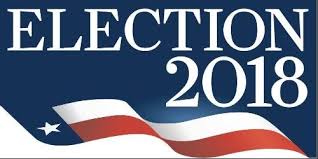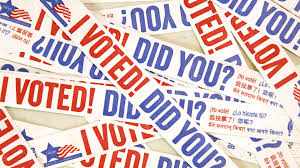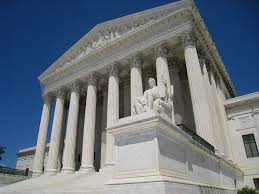Can the Blue Wave Breach the GOP Wall?
Stoking anger over Democrats’ treatment of Brett Kavanaugh, dangling another tax cut, announcing an executive order to supersede the Constitution’s citizen-by-birth amendment, sending troops — first 800, then 5,200, now Blue Wave?: August 21: Pundits saying Democrats fell short of a wave seemed to have forgotten what we report here. Voter suppression and the most severe gerrymandering in history certainly acted as a breakwater against the wave. And little mention that Democrats were also running against a roaring economy. But Republicans have put together a much stronger strategy. Since taking over governorships and state legislatures in the 2010 midterms, which coincided with the decennial census that gave them the power to redraw electoral maps to their advantage, Republicans have erected a formidable wall of obstacles designed to suppress the Democratic vote. Gerrymandering those maps to pack the most undesirable voters into the fewest districts has been maximized more than ever thanks to computer software. And according to the Brennan Center for Justice, 23 states, predominantly controlled by Republicans, have enacted new voting restrictions since 2010: 13 states have more restrictive voter ID laws, 7 with strict photo ID requirements; 11 have laws making it harder for citizens to register; 6 have cut back on early voting days and hours; and 3 made it harder to restore voting rights to people with past criminal convictions. A running battle has been waged in the courts to try to counter the worst of these laws, but there is no keeping up. the fraudulent fraud scare
The common thread in all these election laws is the requirement that voters have identification with their photograph on it. The claim is that this is to prevent the fraud of a voter impersonating someone else, a solution to a problem that doesn’t
The fraud myth has been so successfully spread by the right-wing that an ABC News poll found that 46% of registered American voters believe that voter fraud occurred “somewhat” or “very” often. Among those who said they’d be voting for Trump, two-thirds held those beliefs.
Fraud, of course, was never the reason for photo ID. The fraud scare was to mask the real intent: to make voting difficult for groups that tend to vote Democratic, namely those in the lower-income stratum who tend disproportionately to be blacks and Hispanics. They are more likely not to have a photo ID and will have difficulty getting one. They may not be able to get time off from work. They may not afford the lost wages in order to go to a government facility such as a motor vehicles office to fill out forms and wait on line while their application is processed.
And if they do persevere, states adopting strict identification laws then make it difficult to qualify. To register, a few such as Kansas, demand proof of citizenship. Wisconsin wants even copies of birth certificates from the authorities of the state where born rather than whatever copy one might have in a personal file. Students being another group that leans Democratic, many states refuse to accept student identity cards, even those issued by the states’ own colleges.
There is cost associated with all these requirements, making them something of a throwback to the Jim Crow era when impediments such as poll taxes and literacy tests kept blacks from voting.
What makes it blatantly evident that photo ID laws are meant to block unwelcome voting groups and have nothing to do with fraud is that no photographic identification is required for absentee ballots. It’s no coincidence that absentee ballots are used mostly by whites. throwing open the gates
It is one of the Supreme Court’s worst decisions. In 2013 in a typically partisan 5-4 vote, the conservative wing killed two key provisions of the Voting Rights Act of 1965. To counter election abuses, the Act had required nine states — almost all in the South — and parts of seven others to first obtain permission from the Justice Department before making changes in their voting laws. In Shelby County v. Holder the Supreme Court ended this “pre-clearance”, with Chief Justice Roberts writing that “things have changed dramatically”, that the litmus tests of the old law no longer fit.
Things hadn’t changed but were about to — and dramatically. Within two hours of the decision, Texas moved to enact a voter identification law that had been blocked only the year before under the Voting Rights Act. Alabama and South Carolina followed suit. One day after the court’s decision, North Carolina put forth a law that would require photo identification, cut back early voting by a week, end same-day registration, increase contribution limits, allow secret money to influence elections, and ban registration drives on Sundays, an after-church tradition for blacks.
All such measures curtail practices mostly convenient to blacks and other minorities who have less freedom than others to register and vote on workdays. Another stratagem is to close polling places in predominantly black or Latino counties. The greater distances and the longer lines at fewer places is designed to discourage people from making the effort. Freed of pre-clearance dictates, Republican states in the 2016 election cut 403 polling places in Texas, 103 in Louisiana, 66 in Alabama, 140 of 200 sites in Arizona, 27 in North Carolina. What will we learn about closures after the 2018 elections? Court battles ever since.
The Obama administration sued Texas for its restrictive new law. Its requirement of a driver’s license, a military ID, or a passport would disenfranchise some 600,000 mostly black and Latino voters. After losing in a federal appeals court, Texas took its case to the Supreme Court which, as happened in so many cases, sent the case back to the state to fix. But one month in office, the Justice Department under Jeff Sessions dropped its objections and allowed the strict Texas law to proceed.
A federal court decided North Carolina‘s law had been designed “with almost surgical precision” to depress black voter turnout. The Supreme Court agreed. Republican Party officials retaliated by advising local election boards to choose polling places and voting hours inconvenient to minorities and other Democratic-leaning constituents. A proposition on the midterm ballot asks North Carolina voters whether they want photo ID enshrined in the state’s constitution. Its primary sponsor says, “Our state must not tolerate anyone’s vote being threatened because lawmakers failed to prevent fraud”. An extensive audit by the state board of elections of the 2016 election found that, out of almost 4.8 million votes cast, there was one fraudulent vote that probably would have been avoided with a photo ID law.
Court cases against gerrymandered election districts have hardly made a dent, so widespread has become the practice. This spring the Supreme Court passed up three chances to at least set rules to prevent partisan mapping that results in near guarantees which party will win each electoral district. (The court has stepped in only when gerrymandering indicates a strong racial bias).
In Michigan, which Donald Trump won by a slim 11,000 votes out of 4.8 million cast, gerrymandering gave Republicans 9 of 14 seats in the House and a 27 to 11 advantage in the state senate.
In Wisconsin in 2014 and 2016, a 52% majority somehow won for Republicans 63 and 64 of the 99 seats in the state legislature.
Examples like these are legion in the United States. This page has covered gerrymandering repeatedly from as far back as 2012 in “Will Your Vote Count in the Coming Election?” to most recently ” Gerrymandering Is Here to Stay, and the Left Is Locked Out” .
Suits were filed for two of the gerrymandered Wisconsin districts, but in July the Supreme Court turned them aside, resorting to the all-too-frequent dodge that the plaintiffs lacked standing in one, and had waited too long to bring their case in the other.
The Court sidestepped any definitive ruling in Maryland gerrymandering cases, sending them back to the state.
In May of 2017, a federal court told North Carolina to redraw its maps of two congressional districts which it said had been designed to cordon off the black 2C two-thirds held those beliefs.
Fraud, of course, was never the reason for photo ID. The fraud scare was to mask the real intent: to make voting difficult for groups that tend to vote Democratic, namely those in the lower-income stratum who tend disproportionately to be blacks and Hispanics. They are more likely not to have a photo ID and will have difficulty getting one. They may not be able to get time off from work. They may not afford the lost wages in order to go to a government facility such as a motor vehicles office to fill out forms and wait on line while their application is processed.
And if they do persevere, states adopting strict identification laws then make it difficult to qualify. To register, a few such as Kansas, demand proof of citizenship. Wisconsin wants even copies of birth certificates from the authorities of the state where born rather than whatever copy one might have in a personal file. Students being another group that leans Democratic, many states refuse to accept student identity cards, even those issued by the states’ own colleges.
There is cost associated with all these requirements, making them something of a throwback to the Jim Crow era when impediments such as poll taxes and literacy tests kept blacks from voting.
What makes it blatantly evident that photo ID laws are meant to block unwelcome voting groups and have nothing to do with fraud is that no photographic identification is required for absentee ballots. It’s no coincidence that absentee ballots are used mostly by whites. throwing open the gates
It is one of the Supreme Court’s worst decisions. In 2013 in a typically partisan 5-4 vote, the conservative wing killed two key provisions of the Voting Rights Act of 1965. To counter election abuses, the Act had required nine states — almost all in the South — and parts of seven others to first obtain permission from the Justice Department before making changes in their voting laws. In Shelby County v. Holder the Supreme Court ended this “pre-clearance”, with Chief Justice Roberts writing that “things have changed dramatically”, that the litmus tests of the old law no longer fit.
Things hadn’t changed but were about to — and dramatically. Within two hours of the decision, Texas moved to enact a voter identification law that had been blocked only the year before under the Voting Rights Act. Alabama and South Carolina followed suit. One day after the court’s decision, North Carolina put forth a law that would require photo identification, cut back early voting by a week, end same-day registration, increase contribution limits, allow secret money to influence elections, and ban registration drives on Sundays, an after-church tradition for blacks.
All such measures curtail practices mostly convenient to blacks and other minorities who have less freedom than others to register and vote on workdays. Another stratagem is to close polling places in predominantly black or Latino counties. The greater distances and the longer lines at fewer places is designed to discourage people from making the effort. Freed of pre-clearance dictates, Republican states in the 2016 election cut 403 polling places in Texas, 103 in Louisiana, 66 in Alabama, 140 of 200 sites in Arizona, 27 in North Carolina. What will we learn about closures after the 2018 elections? Court battles ever since.
The Obama administration sued Texas for its restrictive new law. Its requirement of a driver’s license, a military ID, or a passport would disenfranchise some 600,000 mostly black and Latino voters. After losing in a federal appeals court, Texas took its case to the Supreme Court which, as happened in so many cases, sent the case back to the state to fix. But one month in office, the Justice Department under Jeff Sessions dropped its objections and allowed the strict Texas law to proceed.
A federal court decided North Carolina‘s law had been designed “with almost surgical precision” to depress black voter turnout. The Supreme Court agreed. Republican Party officials retaliated by advising local election boards to choose polling places and voting hours inconvenient to minorities and other Democratic-leaning constituents. A proposition on the midterm ballot asks North Carolina voters whether they want photo ID enshrined in the state’s constitution. Its primary sponsor says, “Our state must not tolerate anyone’s vote being threatened because lawmakers failed to prevent fraud”. An extensive audit by the state board of elections of the 2016 election found that, out of almost 4.8 million votes cast, there was one fraudulent vote that probably would have been avoided with a photo ID law.
Court cases against gerrymandered election districts have hardly made a dent, so widespread has become the practice. This spring the Supreme Court passed up three chances to at least set rules to prevent partisan mapping that results in near guarantees which party will win each electoral district. (The court has stepped in only when gerrymandering indicates a strong racial bias).
In Michigan, which Donald Trump won by a slim 11,000 votes out of 4.8 million cast, gerrymandering gave Republicans 9 of 14 seats in the House and a 27 to 11 advantage in the state senate.
In Wisconsin in 2014 and 2016, a 52% majority somehow won for Republicans 63 and 64 of the 99 seats in the state legislature.
Examples like these are legion in the United States. This page has covered gerrymandering repeatedly from as far back as 2012 in “Will Your Vote Count in the Coming Election?” to most recently ” Gerrymandering Is Here to Stay, and the Left Is Locked Out” .
Suits were filed for two of the gerrymandered Wisconsin districts, but in July the Supreme Court turned them aside, resorting to the all-too-frequent dodge that the plaintiffs lacked standing in one, and had waited too long to bring their case in the other.
The Court sidestepped any definitive ruling in Maryland gerrymandering cases, sending them back to the state.
In May of 2017, a federal court told North Carolina to redraw its maps of two congressional districts which it said had been designed to cordon off the black vote. When the redrawn maps were submitted, Common Cause and Democratic voters sued again and the Fourth Circuit appellate court agreed with them. The state took its cases to the Supreme Court which ducked these too, tossing them back to the appellate panel which again rejected the state’s maps on constitutional grounds. But now, two years into this duel, that court has allowed the unconstitutional maps to be used in the November election because time is too short.
In Texas, a federal district court ruled that voter maps the Republican state legislature had drawn were discriminatory against Latino voters. The maps had already been disallowed in 2012 by a Washington DC court, but Texas reinstated them as soon as the Supreme Court eviscerated the 1965 Voting Rights Act’s pre-clearance requirement. The state took the issue to the U.S. Supreme Court which, this June, accepted the unconstitutional maps for use in November.
Republicans have had the power to design the voting districts in 31 states where they control the legislature. In our broken system, the party in power in the legislature is given the tools to keep itself in power. The only check in our check and balance scheme — the justice branch — has shown that it doesn’t want to be involved. That won’t change with a fifth hard-right justice now installed on the Supreme Court. It seems assured that gerrymandering is now so enshrined in the the United States as to be a virtual 28th amendment. throwing them out…
Ohio has a different strategy. Residents who haven’t voted recently are sent a postcard telling them if they do not respond and then fail to vote in the next four years, the state will cancel their registration. It has purged more than two million of its voters from the state’s rolls this way.
At least six other states have similar laws but Ohio is the most aggressive, pursuing voters as soon as they skip an off-year election and then a midterm, which most voters do given America’s shamefully low turnout rates. The Obama administration challenged, saying this approach runs afoul of the National Voter Registration Act of 1993 and its purpose of expanding the voter rolls, and that federal laws as well prohibit states from removing people from voter rolls “by reason of the person’s failure to vote”. Voters should be removed only on discovering they have moved or altered their status, such as committing a felony. Once again, the claim is that purges disproportionately target minorities likely to vote Democratic. In Ohio’s three largest counties, for example, voters in Democratic-leaning neighborhoods have been purged at twice the rate of Republican areas.
Then the Trump Justice Department took office. It switched sides and filed a brief with the Supreme Court against the Obama administration suit and in support of Ohio. In June the U.S. Supreme Court voted 5-4 in Ohio’s favor. …and holding them back
Georgia‘s Secretary of State Brian Kemp may have taken inspiration from Ohio. His purge has taken the form of putting 53,000 registration applications on hold, sitting in his office, subject to a system he instituted called “exact match”, which means if there’s a wrong letter in an address, say, such that it doesn’t match information already on file, an applicant is placed on hold by Kemp and not even notified.
Bad enough, but here’s the rub: Kemp is running for governor, yet has held onto his position as secretary of state, an office that puts him in charge of the election — an election in which he is a candidate! It’s a conflict of interest like no other. His opponent is Stacey Abrams, who just happens to be black. It is she who has attracted these new voters that Kemp is sitting on: Georgia’s population is approximately 32% black, but of the applications in Kemp’s office 70% are black. With little time to go, civil rights groups are suing. life sentence
Nationwide, six million
15,000 — to stir fear of a Honduran invasion with “unknown Middle Easterners” 
— President Trump has been pulling out all the stops to bring Republicans to the polls to keep Democrats from taking control of the House of Representatives. 
exist. Many studies prove this. A 2012 investigation by the News21 journalism project looked at all kinds of voter fraud nationwide, including voter impersonation, people voting twice, vote buying, absentee fraud, and voter intimidation. It confirmed that voter impersonation was extremely rare, with just 10 credible cases. The most comprehensive study, conducted by the Loyola Law School, found that among one billion votes cast in all American elections between 2000 and 2014, there were 31 cases of impersonation fraud.


